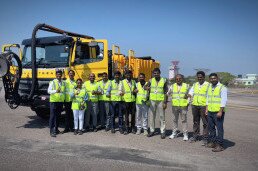
Kobe Airport Fire-fighting and Rescue Drill for Aircraft Accidents
- 2024-11-12
Kansai Airports Kobe is pleased to announce that we will conduct a fire-fighting and rescue drill for aircraft accidents at Kobe Airport on Tuesday, November 19.
The purpose of this training is to verify the effectiveness of Kobe Airport Emergency Plan in the event of an aircraft accident at Kobe Airport, and to implement prompt and appropriate firefighting, rescue and disaster medical services in close cooperation with stakeholders.
Kansai Airports Group will continue our efforts to ensure safe travel and continue various training programs so that passengers can use our airports comfortably.
Date & Time: Tuesday, November 19, 2024, 2:00 pm - 4:00 pm
Location: Kobe Airport maintenance area, Stand No. 1
Organizer: Kobe Airport Emergency Plan Liaison Council
Participants: Approximately 30 institutions including Skymark Airlines Inc., All Nippon Airways Co., Ltd., Fuji Dream Airlines Co., Ltd., West Japan Civil Aviation Bureau Kobe Office, Japan Coast Guard Kobe Security, Kobe City, Kobe City Fire Department, Kobe New Transit Co., Ltd., Self-Defense Forces, Nippon Telegraph and Telephone (NTT) West Corporation Hyogo Branch, Hyogo Prefecture, Hyogo Prefectural Police, medical institutions, Nichii Kobe Port Island Center, Firefighting and Rescue Support Team (Kobe Airport), Kobe Port Island 4 University Council (student volunteers), Kansai Airports Kobe, others
Scale: Approximately 300 people
Scenario: Emergency declared during flight due to troubles and an emergency landing
requested at Kobe Airport. The aircraft stops near the center of the runway after
landing at Kobe Airport and catches fire from the engine No. 2. Many passengers and
crew are injured.
Program:
1. Accident reporting and communication training
2. Mobilization training
3. Firefighting training
4. Warning and entry control training
5. Joint coordination activity training
6. Training by the On-site Command Center
7. Training on the establishment of triage areas, emergency command posts, first aid
stations and no-injury waiting areas
8. Evacuation guidance training
9. Injured rescue training
10. Stretcher transport training
11. Triage activity training
12. Disaster medical activity training
13. Emergency transport training for the injured
14. Training for transporting injured people by helicopters
15. Training for identification of dead bodies (including death confirmation)
16. Training for handling no-injury and mild cases










